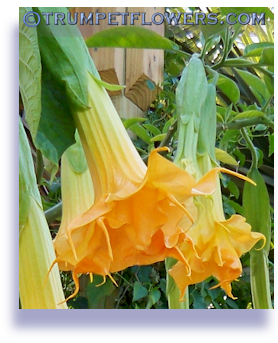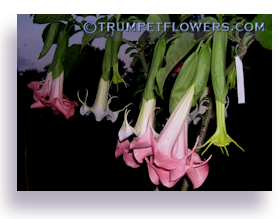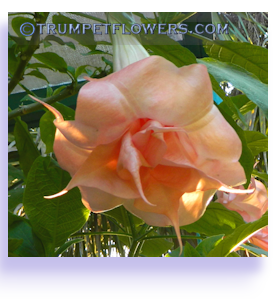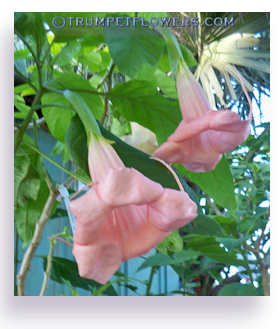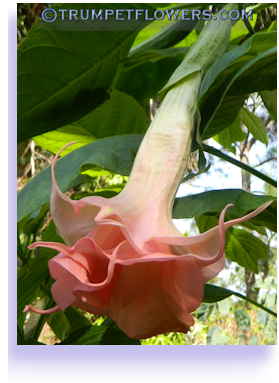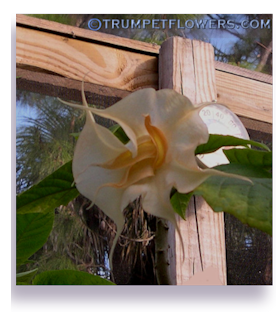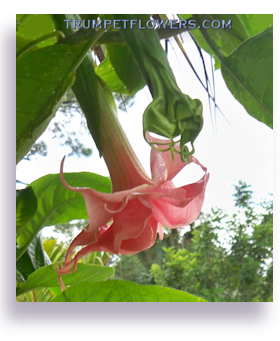Grow GloryBower
Clerodendrum
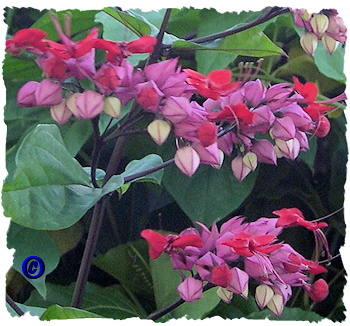 Clerodendrum is a group of several species and cultivars that are enjoyed by beneficial insects and humans alike. Most are subtropical evergreens from the family verbenaceae. Some are vining, others are large shrubs or small trees. All have lovely deep green leaves, and delicate showers of flowers that call to the insects that pollinate them.
Clerodendrum is a group of several species and cultivars that are enjoyed by beneficial insects and humans alike. Most are subtropical evergreens from the family verbenaceae. Some are vining, others are large shrubs or small trees. All have lovely deep green leaves, and delicate showers of flowers that call to the insects that pollinate them.
I keep several different species of clerodendrum, and every one of them lived through light frosts we have here. Temperatures have dropped to 27° and not one died. I do give the vine glorybower, clerodendrum thomsonaie, (pictured above) more protection than the others. They are planted under very large canopied pines. This may make a difference in them keeping their leaves even during these cold snaps. The other species I have do drop their leaves after a frost, but they grow right back in spring, along the same stems. All of the clerodendrums I speak of on this page, I have in my gardens.
One of my favorites is clerodendrum trichotomum. This full bush to tree is loaded with fragrant cascades of blooms after only a few years, and it attracts a carnival of many colorful bees and butterflies. Some butterflies, like Endoclita mamabaricus and Endoclita sericeus, use it as a larval plant for their caterpillars. It is often called the Peanut butter plant, because the scent is similar. It can spread by the roots underground, something that some gardeners don't care for. But if you mow your lawn regularly, they easily cut under the blades.
C. trichotomum is orignally from Asia, and thrives on low mountain slopes and canopy covered edges of forests. It enjoys a moist but bright location, with rich soil. The large, heart shaped leaves of deep green give way around July or August to hundreds of pinkish white flowers, that later turn a deep red with a florescent blue berry in each center. Two shows in one.
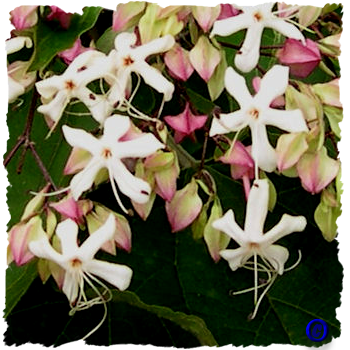 After it flowers, the flowers then fall off, and turn to berries. Each fluorscent blue berry contains a dark gray to black seed. If you want to try growing them from seed, harvest as soon as the blue fruit begins to soften. Clean off the fruit in a vinegar and water mixture, and plant the seed in seed starting soil as soon as you can. Mine usually appear within a month, but are finicky and not all come up.
After it flowers, the flowers then fall off, and turn to berries. Each fluorscent blue berry contains a dark gray to black seed. If you want to try growing them from seed, harvest as soon as the blue fruit begins to soften. Clean off the fruit in a vinegar and water mixture, and plant the seed in seed starting soil as soon as you can. Mine usually appear within a month, but are finicky and not all come up.
Clerodendrum trichotmum can grow into a tree, as high as 50 feet, but usually heights of 20 feet or so are more common. Keeping it in a container is fine, and trimming the top will also keep it more manageable if you prefer it as a patio plant. It will still bloom for you.
Occasionally they will suffer from an iron deficiency. You can use iron pellets, available from Home Depot or Lowes, or Milorganite for direct correction. You could also use Kelp powder in the amount recommended, to correct this issue.
They grow quickly with the proper treatment, and if you fertilize on schedule (twice a month, Miracle Gro is fine or once a week, 1/2 strength) and change up the pots, within one to two of years they can be placed in the landscape at a size of anywhere from 3 to 6 feet tall. They like moisture, so until the root systems become well established, keep them deeply watered at least twice a week.Give them a loamay and light soil for best results. Dappled sunlight works best for ,clerodendrum deliciosum, trichototmum, and thomsoniae. Some other cultivars can tolerate more sun, but I protect all from the hottest, sunniest part of the afternoon Florida sun by placing in areas of the yard where another larger building or tree offers this.
If placed in the ground, use the fertilizer spikes, fruit and nut type, twice a year. Once in spring and then again in mid∼summer.
Clerodendrums do well in the climate belt near the equator, but many live in temperate regions. Most of them do well in large containers, where they can be brought inside if the weather is too cold. If you do plan on keeping them potted, make sure the soil is rich and loamy, well draining and fertilize once a week, (1/2 strength) for the best possible show of flowers. Clerodendrum grow relatively quickly.
The bleeding heart clerodendrum, or c. thomsoniae, (also called deliciousum, see top photo) is a semi∼tender species that twines and vines. The branches start green and then become woody, similar to mandevilla's habit. It is best to give it a strong trellis or fence to grow on. If it is left untended, it will put shoots out across the ground, sprout up, and recreate itself there. In nature it sprawls across the ground in huge masses. Here in zone 9, I leave mine in the ground all year round. We have a handful of light frosts each winter. Although they then lose their leaves, the plant's stems and roots survive, because I have planted them under tall pine and palms that protect them. By March, they are back in full green, and by the end of April they are already beginning to bloom. Zebrawing and swallowtail butterflies begin to arrive, attracted by the briught red and pink blooms and of course, the nectar each contains.
Clerodendrum can be propagated by stem cuttings, root divisions, air layering, and by fresh seed. As I mentioned, some will send sprouts up from the roots as they spread. These can be gingerly removed and repotted. Make sure you get enough root and hair roots from the cut piece to insure it's survival. Nestling such a rooted piece in a bit of unmilled sphagnum moss and then the rooting soil will help.
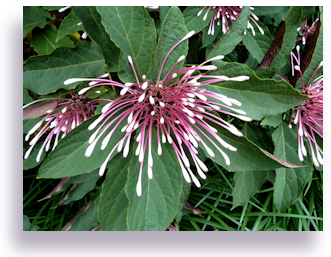 Clerodendrum quadriloculare is another fairly common clerodendrum here in S. W. Florida. The Starburst or Shooting Star bush, it is a medium to fast grower, is shrub like in appearance, and needs to be pruned regularly when reaching full height, 8 to 18 feet. That is, here in the States. In Asia, this plant becomes a full blown tree, and can grow to 50 feet.
Clerodendrum quadriloculare is another fairly common clerodendrum here in S. W. Florida. The Starburst or Shooting Star bush, it is a medium to fast grower, is shrub like in appearance, and needs to be pruned regularly when reaching full height, 8 to 18 feet. That is, here in the States. In Asia, this plant becomes a full blown tree, and can grow to 50 feet.
Place it in morning sun and afternoon protection from summer sun for deeper green foliage. The underneath leaves are a purple shade, giving the shrub a handsome look even when not in bloom.
It is a late winter to early spring bloomer. When you see your first one in full bloom, you'll understand why so many gardeners do grow this fantastic plant. Covered in hundreds of thin, plumage like flowers, it will be the talk of the neighborhood. It also attracts hummingbirds, and the Eastern Comma, along with other species of butterflies.
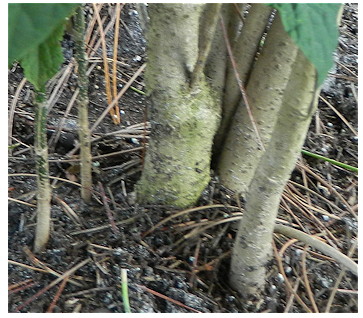 Common names include firecracker clerodendrum, shooting star, and starburst plant. It orginates in the Pacific isles of Asia and Africa.
Common names include firecracker clerodendrum, shooting star, and starburst plant. It orginates in the Pacific isles of Asia and Africa.
Fertilize starburst clerodendrum three times a year with flowering tree spikes, once in spring, summer and again in mid∼the fall, around September. If in a pot, weakly fertilize once a month during the growing seasons. Inbetween, foliar feed once a month for an outstanding specimen. You can 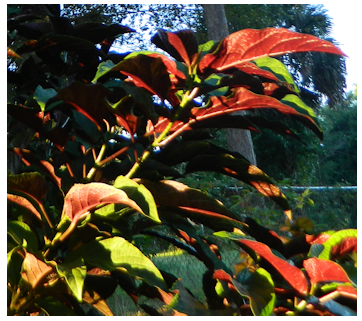 trim it anytime, but right after it has finished blooming is best. Trimming can stimulate it to sucker, or put out baby plants at it's feet, sometimes as far away as 6 feet! Like many clerodendrums, this one throws out baby plants along the ground. Either mow them over if you don't want them, dig or pull them up, or leave it in a large patio container for viewing on your lanai. The suckers you may dig up can be potted up in a shady place for a month or so in warm weather and they will make you new little plants to give to family and friends.
trim it anytime, but right after it has finished blooming is best. Trimming can stimulate it to sucker, or put out baby plants at it's feet, sometimes as far away as 6 feet! Like many clerodendrums, this one throws out baby plants along the ground. Either mow them over if you don't want them, dig or pull them up, or leave it in a large patio container for viewing on your lanai. The suckers you may dig up can be potted up in a shady place for a month or so in warm weather and they will make you new little plants to give to family and friends.
Other clerodendrums include the deciduous bungei, also called glorybower, and the larger white rose∼like flower of clerodendrum chinese. C. wallichii puts out hanging showers of white flowers that are a delight to all who see. Whatever or however many you choose, clerodendrums are really a beautiful addition to any lawn or landscape plan.
Tags: clerodendrum, glorybower, clerodendrum, glorybower, peanut butter plant, starburst clerodendrum, grow clerodendrum, butterfly attractant, Starburst clerodendrum, Eastern Comma, propagate clerodendrum,

